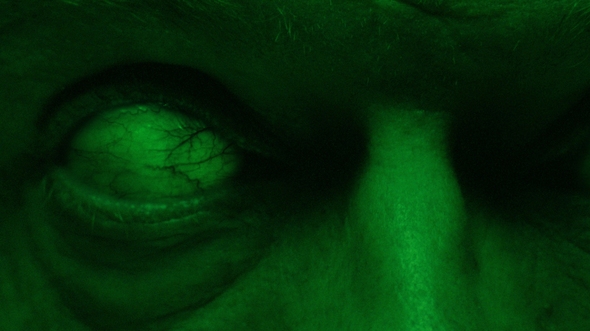Wednesday, 9 April 2014
Slashers: "The Strange Colours of Your Body's Tears"
The French writer-directors Hélène Cattet and Bruno Forzani specialise in meticulous recreations of the Italian slasher movies they doubtless grew up watching, illicitly, under the covers after lights-out - but the pair's films are really abstractions, suggesting what giallo might look like as viewed through the prism of the contemporary art world: they could almost be installations inspired by Deep Red or Suspiria, much as Douglas Gordon took Hitchcock's Psycho and stretched it into a 24-hour artefact. Their house style is to frame everything in extreme close-up: to its detractors, it can appear hectoring and insistent, over-emphatic. Where Dario Argento, a self-taught student of architecture, traditionally pulled his camera back to frame his panicked or predatory characters in space, Cattet and Forzani - perhaps acknowledging how creaky giallo might now appear to those ADD-afflicted thrill junkies raised on Hostel and Saw - zoom in and break the body down into its constitutent parts: flickering eyes, silent screams, heaving breasts.
What we have here is giallo for the YouTube generation, hacking up and splicing together individually distinctive shots - bad dreams, crafty borrowings and other fevered imaginings - until they become a disturbing or otherwise impactful blur; the cutthroat razor wielded in those first-wave giallos as a murder weapon has here been reappropriated as an editing tool. This decidedly postmodern methodology proves particularly appropriate in the case of their latest, The Strange Colours of Your Body's Tears, which ultimately reveals itself to be a concept horror movie (akin to a concept album) about a body in the process of decomposition. This pair's debut Amer (2009) was deemed commercial enough to play in cinemas, encouraging the filmmakers to push their aesthetic further still: Strange Colour begins as a baroque game of cherchez la femme in an apartment block apparently stalked by a killer, then divides and subdivides to the point of narrative incomprehensibility.
These filmmakers tend to think in sequences, and concern themselves less with how these sequences might connect. Early on, there's a vivid substory in which one old dear tells our hero how her husband went missing several years before in the flat immediately above their own, wherein the directors work wonders with a doctor's stethoscope, long matches and considered sound design. A later, Lynchian creepout involves the protagonist finding himself assailed by doppelgangers of his naked self (splitters!), and dying over and over again until he wakes from slumber. Mostly, the film's going for instant, grabby effect, sacrificing coherence in search of the next thing that might catch and hold the eye. This process might see off anybody who wants their horror linear - The Quiet Ones plays nationwide from Friday, if that's what you're looking for - but it's never boring; instead, The Strange Colours of Your Body's Tears comes to compel as an abstract study of the lacerated self. You're forced to make thematic connections: the film is full of tearing, shattering and ripping away, and it isn't just bodies that come apart here, throwing up crystalline blood drops in slo-mo like rubies, but the screen itself, sledgehammered and sliced into a thousand pieces.
I don't doubt there will be some who dismiss these pieces - and Strange Colours is very much of a piece with the directors' earlier work - as artfully dressed (or undressed) titbits, a new line of horror tchotchkes rather than anything more substantial. Just as there are those purists who turn up their noses at the Insidious movies for carrying with them the whiff of popcorn, one might react with equal disdain to a work that trails the smell of the gallery with it: consider, just for starters, the way a slow pan into a scalp laceration seeks to recall both Godard's coffee cup and Courbet's vagina. (Hey, where's the Doug Bradley cameo?) Yet all these hints and teases, drips and drabs do eventually pool together and carry us somewhere: the genuinely bravura final twist explains that rather highfalutin title, while reframing everything we've been watching as a feminine equivalent to Matthew Barney's testicular Cremaster movies. More than gifted manipulators of sound and image, Cattet and Forzani are artists at large in a genre sometimes prone to hackwork.
The Strange Colour of Your Body's Tears opens in selected cinemas from Friday.
Subscribe to:
Post Comments (Atom)

No comments:
Post a Comment